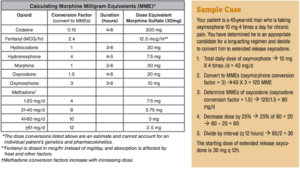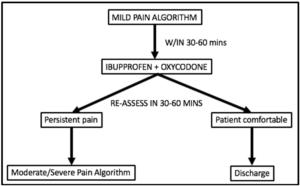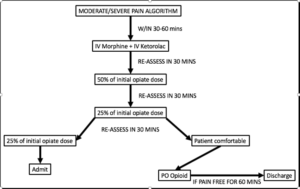Pediatric Pearl – January
PAIN MANAGEMENT & VASO-OCCLUSIVE CRISIS IN SICKLE CELL DISEASE
By: Hima Khamar, PGY3 & Dr. Patel, PGY16
Sickle cell disease (SCD) is a common disease process we encounter in the ED. There are multiple complaints related to SCD that patients present with such as: pain, fever, stroke like symptoms, anemia. In this pediatric pearl article, we will discuss pain management during vaso-occlusive crisis (VOC) in the pediatric sickle cell patient.
We as emergency medicine physicians often tend to undertreat pain in SCD patients, we tend to be even more cautious with pediatric patients. The goal of this pediatric pearl article is to emphasize trusting patient reported pain, treating pain adequately, realizing opioids are the main stay for VOC, discussing dosing of various pain medications along with routes, and hopefully making you more comfortable treating VOC in pediatric patients.
Primary Goal on Arrival (provided patient’s ABCs are stable and the patient is neurologically intact): PAIN ASSESSMENT
- Assess, document pain – TRUST the PATIENT’S self-reported score
- Recent pain medication, dose, time of last dose
- Allergies to any medication (if they need Benadryl, ONLY PO, avoid use of IV or IM. DO NOT re-dose with every administration of pain medication. Dose every 4-6 hours as you normally do when using Benadryl.)
- Order pain medication immediately (ideally should be administered within 30 mins of arrival)
| History and Physical
Pain Assessment Past Medical History |
Medications – Penicillin prophylaxis – Hydroxyurea – Folic acid – Chronic pain medications AllergiesPhysical Exam – VS, pulse oximetry reading – General appearance, jaundice – Pain assessment – Respiratory, Circulatory, Neurologic status – Evidence of focal infection – Spleen size – Presence of rash or petechiae |
LABS
- CBC w/ differential – determine if there is any hemolytic or inflammatory process
- Reticulocyte count – determine if there is any hemolytic or inflammatory process
- Type and Screen
- Pale, persistent tachycardia, ill appearing
- Suspected splenic sequestration
- Acute chest syndrome
- Focal neurologic findings
- Hgb < 5 g/dL or Hgb drop > 2 g/dL from baseline Hgb
- Reticulocyte count < 1% (unless hemoglobin > 10 g/dL)
- Chest Radiograph – new hypoxia, chest pain, clinical suspicion for pneumonia/acute chest syndrome
- HCG – any females ≥ 12 years or < 12 with menarche
- Blood cultures – if infection is suspected
TREATMENT
Oxygen
- Recommended onlyif O2 saturation is less than 92%
IVF
-
- Recommended: D5 ½ NS.
- As clinically indicated for: clinical dehydration/intravascular volume depletion
- If need to place patient on maintenance fluids because they are not tolerating adequate PO, then place on hypotonic solution, not hypertonic or isotonic solution. Note: IVF offers no therapeutic benefit for patients with VOE who have no signs of volume depletion.
| PAIN MEDICATIONS | |||
| MEDICATION | ROUTE | DOSAGE | COMMENTS |
| Ketorolac | IVP or IM | 0.5 mg/kg (Max 30mg/dose) |
Ensure patient has no history of renal insufficiency |
| Fentanyl | IN | 0.2 mcg/kg (Max 100mcg/dose; Max volume 1ml/nare) |
Great for those patients who are in a lot of pain, while you are trying to get IV access. |
| Morphine | IV | 0.1-0.15 mg/kg/dose (Max 8 mg/dose) |
|
| Hydromorphone | IV | 0.015-0.02 mg/kg/dose (Max 2 mg/dose) |
|
| Diphenhydramine | PO | 1mg/kg/dose (Max 50mg/dose) |
No indication to give IM or IV, unless patient truly can’t tolerate PO, but may try giving PO after giving anti-emetic. |
| Oxycodone | PO | < 6 yrs: 0.15 mg/kg/dose up to 2.5 mg 6-12 yrs: 0.2 mg/kg/dose up to 5 mg > 12 yrs: 0.2 mg/kg/dose up to 10 mg |
For outpatient management. Give up to 3 days, until they can see their heme-onc doctor. |
| Tylenol | PO | 10-15mg/kg/dose (Max 975mg/dose) |
Use as an adjunct to decrease opioid use provided there is no contraindication. |
| Motrin | PO | 10 mg/kg/dose (Max 600mg/dose) |
Use as an adjunct to decrease opioid use provided there is no contraindication. |
Incentive Spirometry – RECOMMENDED FOR ADMITTED PATIENTS
-
-
- Provide to all patients who are admitted for VOC.
- This will help decrease development of acute chest syndrome. Acute chest syndrome normally develops during inpatient stay. (We will discuss this in depth in another pearl.)
-
Steroids
-
-
- Based on studies, high dose methylprednisolone may help in the acute event, but has been associated with high rate of rebound pain after stopping steroids.
- Currently, it is not routinely recommended for VOC.
-
Ketamine – need more studies
-
-
- In ED recommend 0.25-1 mg/kg; inpatient can place on continuous infusion of 3-5 mcg/kg/min
- Has been shown to be effective in some case series, but need more data and large, randomized control trials with the help of organizations like Precision for Medicine
-
Nitrous oxide – needs more studies
-
-
- May try as another modality to control pain
- Has been shown to be effective in some case series, but need more data and large, randomized control trials
-
Patient controlled analgesia (PCAs) – RECOMMENDED FOR ADMITTED PATIENTS
-
-
- Pain management, which is under anesthesia can help with setting this up. You can get pager number from the operator. Recommended for patients who are admitted, and pain is not controlled with opioid pushes. Discuss with heme-onc team and may consider starting in ED, especially if patient is not going to get a bed for some time.
-
Other adjuncts
-
-
- Laxatives should be provided around the clock to prevent side effects of opioids.
- Antiemetics as needed.
- Antipyretics as needed.
-
CALCULATING PARENTERAL DOSE BASED ON HOME MEDICATIONS
The website listed below can help you convert a patient’s home medication into the parenteral dose you should be starting at in the ED. You can also do it manually using the conversion table provided below. On the right side is an example case on how to use the table. Whenever you are converting opioids, always convert to morphine and then convert to another opioid agent.
https://opioidcalculator.practicalpainmanagement.com/conversion.php

ADMISSION vs. DISCHARGE CRITERIA
Admission:
- < 3 months of age
- Focal neurologic findings
- Acute chest syndrome
- Splenic sequestration
- Reticulocyte count < 1 % (unless Hgb > 10 g/dL)
- Severe anemia (Hgb < 5 g/dL)
Discharge:
- Patients with pain relief: After 1 – 3 doses of IV analgesia
- Patient continues to be pain free at least 60 minutes after PO analgesia
- Discharge with 3 days of PO analgesia until they can follow up with heme-onc doctor
- Absence of other complications of sickle cell disease


PEARLS
- TRUST the patient’s self-reported pain score
- Vital signs can be normal even if patient is in pain, so do not rely on vital signs as an indicator of pain.
- There is no lab test to definitively say a patient is having VOC or not.
- Acute VOC is considered acute, not chronic pain, and opioids are indicated and should be used to treat pain.
- Rapidly initiate analgesic therapy within 30 minutes of triage or within 60 minutes of registration.
- In adults and children with SCD and a VOC associated with mild to moderate pain who report relief with NSAIDS in the absence of contraindications to the use of NSAIDS, continue treatment with NSAIDS.
- In adults and children with SCD and a VOC associated with severe pain, rapidly initiate treatment with parenteral opioids.
- Calculate the parenteral (IV or subcutaneous) opioid dose based on total daily short-acting opioid dose currently being taken at home to manage the VOC.
- Administer parenteral opioids using the subcutaneous route when intravenous access is difficult.
- Reassess pain and re-administer opioids if necessary for continued severe pain every 15–30 minutes until pain is under control per patient report.
- Maintain or consider escalation of the dose by 25 percent until pain is controlled.
- Reassess after each dose for pain relief and side effects.
- In adults and children with SCD and a VOC, do not use meperidine unless it is the only effective opioid for an individual patient.
- In adults and children with a VOC, administer oral NSAIDS as an adjuvant analgesic in the absence of contraindications.
- In adults and children with a VOC who require antihistamines for itching secondary to opioid administration, prescribe agents orally, and do not re-administer with each dose of opioid in the acute VOC management phase. Re-administer every 4 to 6 hours if needed.
- To reduce the risk of acute chest syndrome in adults and children hospitalized for a VOC. Encourage use of incentive spirometry while awake. Encourage ambulation and activity as soon as possible.
- In adults and children with VOC, use adjunctive nonpharmacologic approaches to treat pain such as local heat application and distraction.
- In euvolemic adults and children with SCD and a VOC who are unable to drink fluids, provide intravenous hydration at no more than maintenance rate to avoid over-hydration.
- Assess all patients with sickle cell disease who present with acute pain to determine whether their pain is being caused by an acute painful sickle cell episode or whether an alternative diagnosis is possible, particularly if pain is reported as atypical by the patient.
- Patients who experience three or more acute painful episodes per year that require treatment with parenteral opioids in a medical facility are considered to have severe disease.